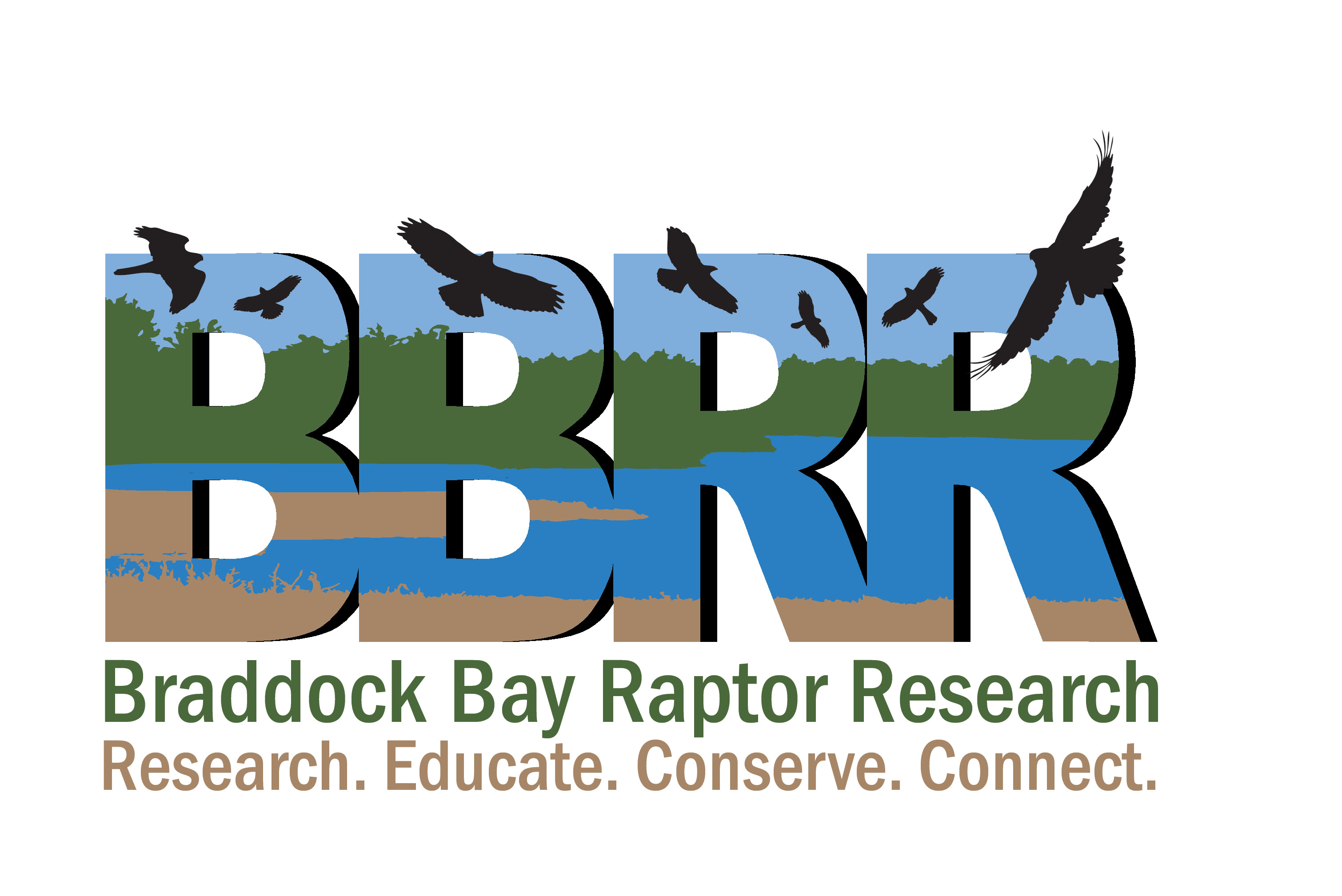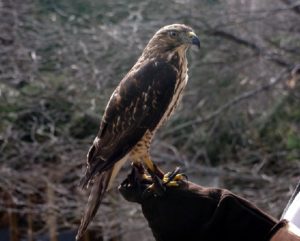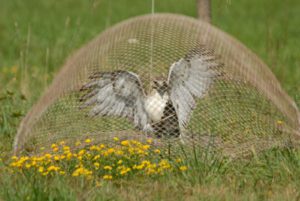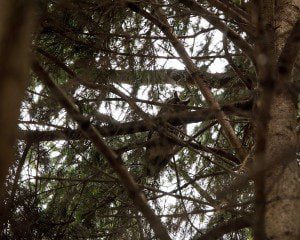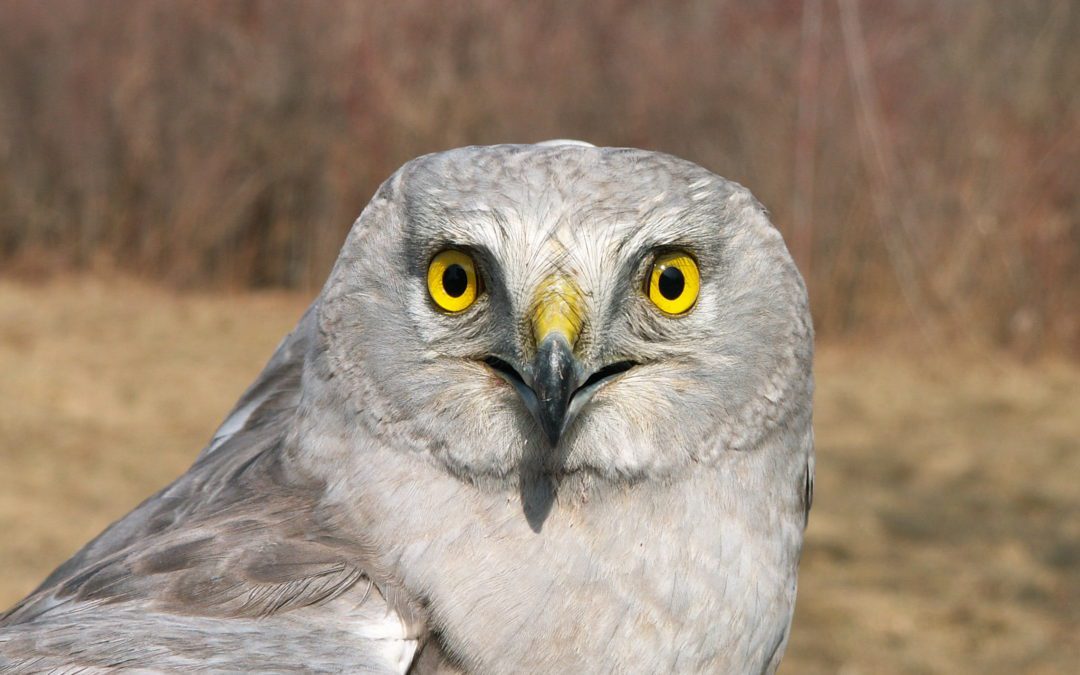
Featured Species: Northern Harrier
Written by Jim Adams
Gliding and bouncing low over the grasslands and marshes of New York state, the Northern Harrier (Circus cyaneus) is one of New York’s more distinctive birds of prey. Unlike high soaring eagles and hawks, harriers spend most of their time close to the ground (except during migration), be it while hunting, roosting, or nesting. In addition to their low altitudes, Northern Harriers can be easily identified by their long tails, white rumps, and owl-like faces.
New York state is on the southern edge of the breeding range of this species with most Northern Harriers nesting in lower Canada south of the tundra and in Alaska. Unlike the stately nests of the Bald Eagle, harriers nest in tall grassland fields on the ground. During their winter stays in New York state they will also roost communally on the ground, which is why winter birders frequently see more than one harrier hunting over the same field. Small to medium sized mammals (e.g., field mice and voles) and birds are the main items on this raptor’s menu. Harriers are among the early spring migrants, with their communal roosts breaking up in late February and early March so that they can be on their way back to their nesting grounds. Being a bird of the fields, Northern Harrier numbers probably increased when settlers came to New York state and cleared the forests to produce farmland. As agricultural land use have since diminished and the forests subsequently regrown, harrier numbers have declined in response to the loss of field habitats.
The Northern Harrier is the featured species of this year’s Bird of Prey Days event. Come on out to learn more about this stunning raptor.
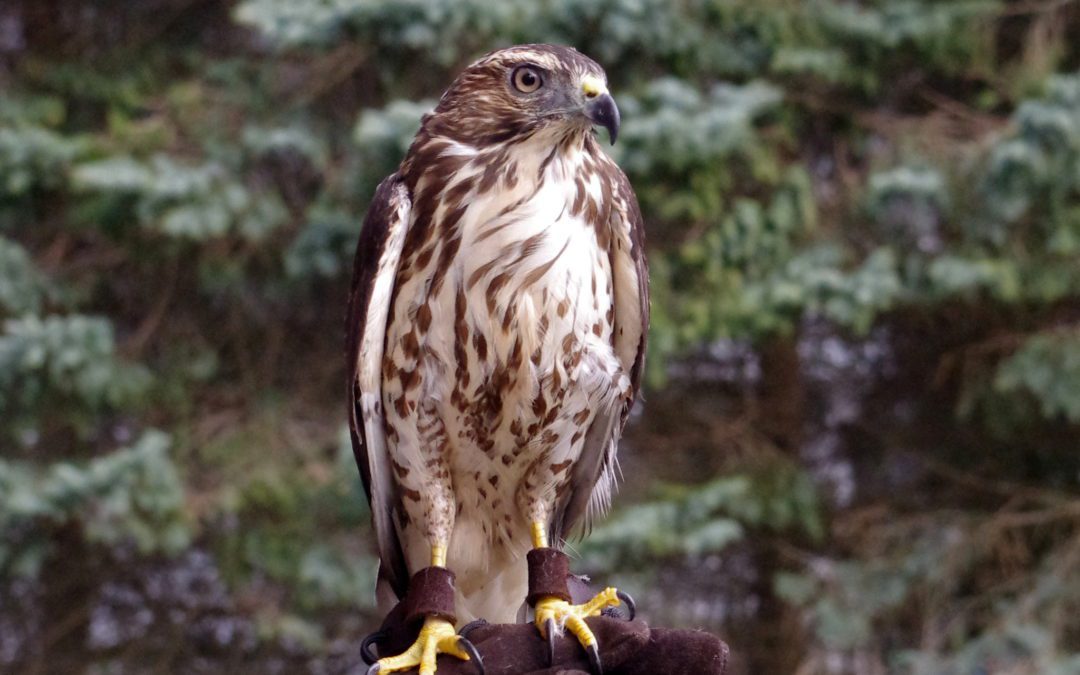
New Feathered Ambassador for BBRR
Nothing excites our visitors more than seeing raptors up close and personal. There are many ways to do that at Braddock Bay, from the hawkwatch to the banding station to the Owl Woods. Encountering wild raptors in their natural habitat is surely a thrill. Just as thrilling is getting to see these birds even more closely, in a way that helps people really connect with the species. BBRR is excited to announce the arrival of a new ambassador for the organization – this non-releasable Broad-winged Hawk.
The Broad-wing comes to us from Kindred Kingdoms Wildlife Rehabilitation Center, north of Syracuse, NY. He came into the care of wildlife rehabilitator Jean Soprano after he was hit by a car near Watertown, NY. Unfortunately he sustained injuries that would prevent his release back to the wild. He is now missing his left eye and also has some permanent damage to one wing. Despite these injuries, he is quite a beautiful bird, and has a very charming personality, making him a good candidate for educational use.
The Broad-wing is a juvenile, hatched sometime last summer, so he is sporting the plumage of a youngster right now. He will molt into his adult plumage this coming summer, which will give him that diagnostic wide white tail band, and his streaky chest will change to one with rufous colored barring. It is believed that he is a male due to his size being on the lower end of the spectrum, and males tend to be smaller than females in the raptor world.
After only a couple of months in his new BBRR home, the Broad-wing has proved he is ready to go out into the world and take on his new job as an education bird. He recently made his first appearance at a local Brownie Troop meeting. The girls were learning about backyard birds and had plans to create some homemade bird feeders. They were the perfect audience to start the Broad-wing out on his new career, as he showed he was very comfortable in his unfamiliar surroundings.
BBRR’s Broad-winged Hawk is the first addition to the new education bird program we are calling Raptor Connections. The goal is to add 3 more birds to the collection, all of which will be program birds, available for outreach and other educational appearances. Stay tuned for updates as we acquire new birds. If you would like to schedule a Raptor Connections program with our Broad-winged Hawk (and other birds in the future), contact Daena Ford at information@bbrr.org or 585-267-5483.
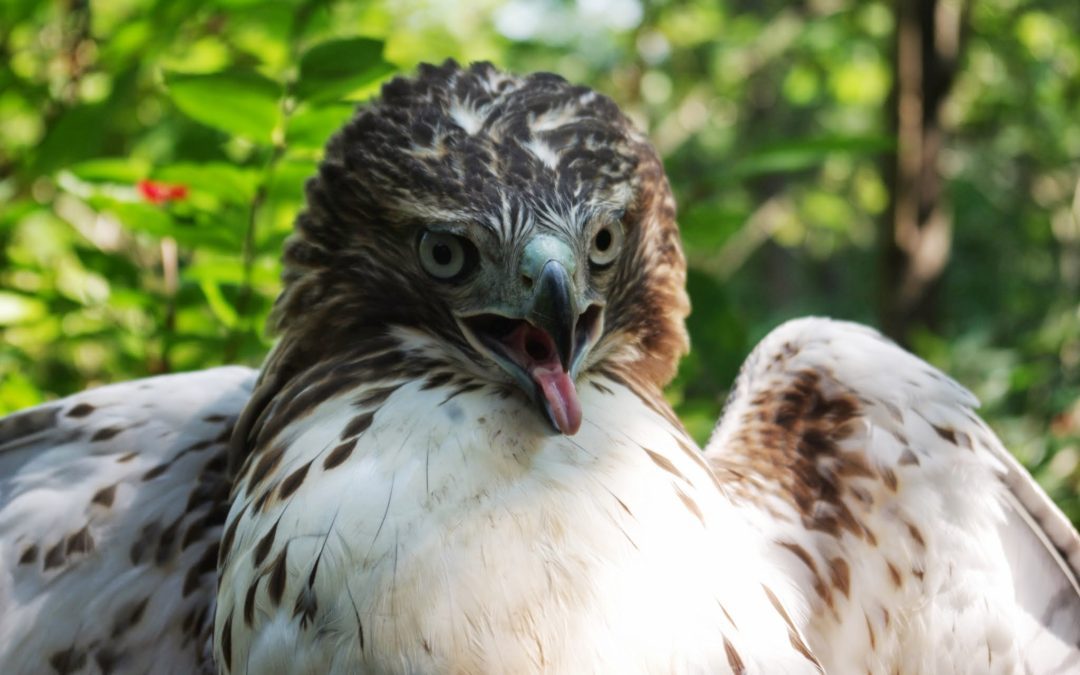
August Red-tail Season Begins!
By Barbara French, BBRR Raptor Bander
“There’s a kettle with 7 eagles!”
The excited text blinked on my phone, and I didn’t even have to wonder who it came from — master bander and licensed eagle bander, Dan Niven. A few exchanges later, I discovered he was out hawk watching, and what was coming next would be a flurry of plans to get Main Blind opened as soon as possible for our late summer/early fall banding season. In a few days, we were out mowing the field and inspecting our equipment in preparation for an on-time start, and perhaps a slightly early one.
Traditionally, Main Blind opens on August 1 for what is called “Red-tailed Hawk natal dispersal” — a period of time when young Red-tails, some just weeks from fledging, are taking to the skies in number after their parents have stopped hunting for them. While some will stay near where they were born, most Red-tailed Hawks scatter, or disperse, sometimes hundreds or thousands of miles, creating a kind of false northern migration as they are carried on warm summer southwest winds up to the lakeshore. Braddock Bay bands the vast majority of its Red-tailed Hawks, mostly these hatch-year birds, during the months of August and September.
This spectacle is not as well advertised as our famous spring migration. People hawkwatch, but we do not have a hired counter like we do in spring. But late summer is every bit as dramatic as spring — and on some of the days, particularly in the middle of August, downright jaw-dropping. We have had days with “every base loaded” (a Red-tailed hawk caught in every trap in the field) and a couple dozen more circling in the skies above us. It’s a truly awe inspiring sight.
Juvenile Red-tails do not have their famous red tail feathers yet — they will not get these until their third year of life. But the other notable field marks are usually present, including the belly band and the dark patagial markings. These youngsters are inexperienced hunters and are comparatively easy to trap as compared to their more experienced, wily elders (we catch far, far more juveniles than adults), which makes them very interesting to watch as they come into our station.
If you are lucky and our licensed eagle bander is working that day, you might even see a magnificent hatch-year Bald Eagle up close. Many novices to birding do not realize that Bald Eagles do not have their iconic white heads until they are much older. At about 3 1/2 to four years of age, the white head feathers become most visible, although they progressively lighten up through the previous years. Hatch-year eagles are nearly entirely brown, but every bit as large, strong, and impressive as their older counterparts.
This fall, Braddock Bay Raptor Research will be announcing when banders will be at our Main station through our Twitter feed, @BraddckBayHawks. Updates will appear either the evening before or the morning of banding; since weather and wind direction can be so variable, we sometimes do not know until the morning of a banding day whether we are going to have good conditions. If response is good, we will continue this practice for our spring season in 2017.
Just wear bug spray, and a lot of it. The mosquitoes are not as bad as they were last year, but the biting flies are out in force.
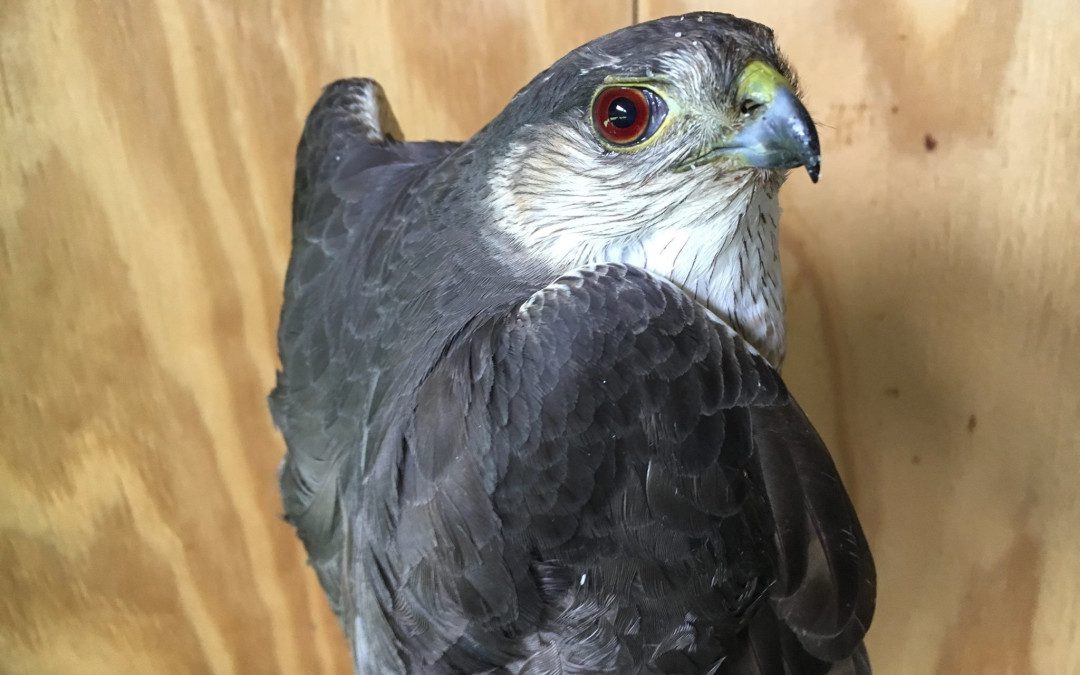
Marvelous May!
Braddock Bay fans often enter into the month of May lamenting that the hawkwatching season has past its peak, and it’s all downhill in terms of raptor migration at least. It doesn’t help that our eyes are easily turned to the colorful menagerie of warblers and other songbirds that make their way along the lakeshore, too. Warblering is a nice distraction on days when hawks are just not cooperating (and sometimes when they are.) While it is true that the season’s end is closer at this point, it is far from over and there can be plenty of exciting raptor moments left to be had as the days get longer and the temperatures warm (for the most part!).
The raptor gods seemed to smile on us early in the month, or take pity on us perhaps, for even on a few days with Northeast winds, we still had some decent flights. Take May 3 for example, when over 6,000 Broad-winged Hawks filtered through, and 52 Bald Eagles as well! http://hawkcount.org/day_summary.php?rsite=353&ryear=2016&rmonth=05&rday=03 A little over 2,000 Sharp-shinned Hawks were also tallied in May, which is almost half of the season total.
Speaking of Sharpies, the banding stations had some great days in May, reminiscent of the good ol’ “Sharpie Madness” days. Over 150 Sharp-shinned Hawks were banded just during the month of May, and mainly over the course of just a few days. A nice variety of adults and immatures, males and females were captured. One of them is pictured above – a gorgeous adult female that was banded and photographed by Barbara French.
The hawkwatch season also ended on a high note, with some great sightings to boast. The morning of May 25 brought a rarity to our site, as a Mississippi Kite was sighted! The last Mississippi Kite seen at Braddock Bay was in 2012. That same day, later in the afternoon, not one but TWO Swainson’s Hawks were tallied as well! The first to be seen was a light morph, and a dark morph followed it about 20 minutes later. http://hawkcount.org/day_summary.php?rsite=353&ryear=2016&rmonth=05&rday=25
Two season records were also reached at the hawkwatch in 2016. First, we had a record number of Peregrine Falcons with 51 for the season! The previous season record was 45 back in 2004. Thanks to the extra efforts of counter Ryan MacLean, we also tallied up a new season record for Bald Eagles which ended up being 664 for the season! The previous record was 648 counted by Luke Tiller in 2013. To think back to the early days when the hawk counts were just beginning, in the late 1970’s and 1980’s we were lucky to see a couple dozen of these magnificent birds. Their comeback is truly a conservation success story.
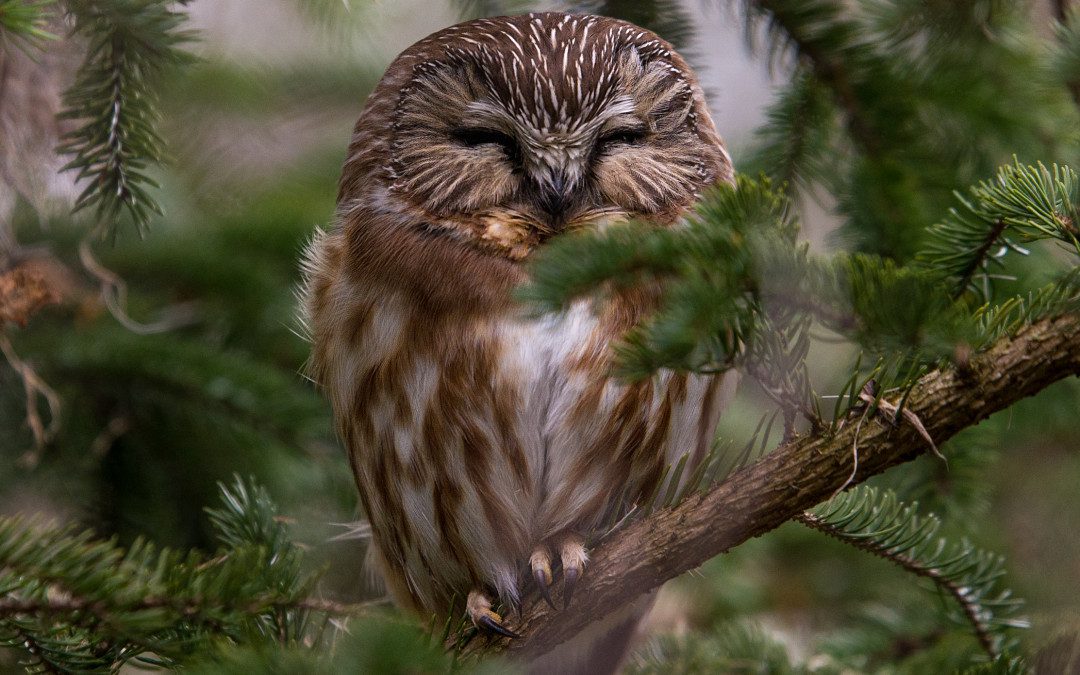
An Owl “Hat-trick”
Each spring, BBRR volunteers survey the Owl Woods for roosting owls that are utilizing the area as a stop over during migration. Information gained from this survey helps is used to monitor the habitat usage by the owls, and in turn helps us to manage and protect the area for the future. While the science behind this data collection is important, no one will deny that it is a true privilege to observe these magical raptors in their natural habitat. Check out our Owl Roost Survey page for more info.
Read on to see just how magical the woods can be at times here at Braddock Bay, and enjoy the account and photos by BBRR volunteer Zaphir Shamma.
On March 25, my wife Tanya and I were surveying for owls in Owl Woods. The day was cold and gray with strong winds. Not the best day to be out, but we were hopeful. As usual, we started out in the “classroom”, then met a man from Canada who said there was a Saw-whet back in the pines. We followed in the general direction of where he pointed and quickly found the spot. We could see a Northern Saw-whet Owl about 8 feet high and tucked deep into the tree. The owl was partially obscured by branches from every angle, but we had nice views of its front. It didn’t appear to be too concerned that we were there, and kept its eyes closed while we viewed it.
We then moved down the path in the direction of the raptor banding station. Tanya wanted to investigate that one large spruce that is off the trail on the right. While searching that area, Tanya reported that she unintentionally flushed “something” and it flew off towards the east. We continued on down the path and rounded the loop. As we began to explore the tall pines on our left, Tanya stopped and said she saw an owl. She pointed about 30 feet off the ground towards a thick pine that was blowing in the wind. The bows were swinging back and forth and finally, I was able to see what she saw (but only for a second). The wind-driven bows would hide, uncover briefly and then re-hide this owl. I took photos as best I could while trying to time the moving branches. While discussing if we should go back and get a better camera lens, the bird pooped, and then bolted silently in a northern direction. It was big and silhouetted, so we couldn’t tell what it was. Once we got home and examined the photos, it turned out not to be a Long-eared Owl as we suspected, rather…it was a Great Horned Owl! We feel that this was the same bird that Tanya had accidentally flushed about 15 minutes earlier.
Tanya and I continued to move back towards the entrance of Owl Woods, searching as we went. Once we got close to where the paths come back together, we came across Jim Saller (BBRR volunteer) who had spotted a Long-eared Owl. We quietly joined him and looked at a beautiful bird high in the canopy. It was dark, back-lit and silhouetted, but the outline was crisp and we knew we had a Long Ear. Photos were taken and we moved on.
All in all, not bad for a gray, cold and windy day. Three different owl species (an Owl Hat-trick) in the woods that we have grown to love.
